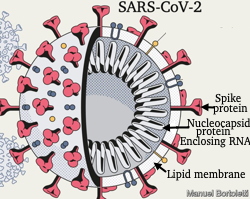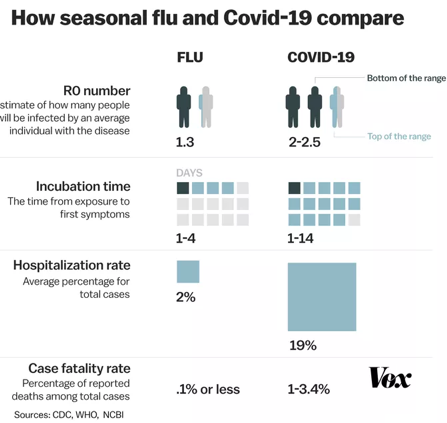 Health
Health
 Corona Virus
Corona Virus
 Coronavirus Facts
Coronavirus Facts
Don's Home
 Health
Health
 Corona Virus
Corona Virus
 Coronavirus Facts
Coronavirus Facts
| Contact |
| Other Pages: Coronavirus statistics | Coronavirus Safety - Prevention - Treatment | Personal Protection Equipment | Coronavirus Facts | | |
 First described in detail in the 1960s, the coronavirus gets its name from a distinctive corona or 'crown' of sugary-proteins that projects from the envelope surrounding the particle.
First described in detail in the 1960s, the coronavirus gets its name from a distinctive corona or 'crown' of sugary-proteins that projects from the envelope surrounding the particle.
RNA is usually generated from DNA as part of cell replication.
Retroviruses are "retro" because they reverse the direction of the normal gene copying process. The virus genes are copied into the DNA where it replicates thru the normal cell replication process which ends up making viral proteins.
Viruses require a living host to replicate as opposed to bacteria which are larger single-celled microorganisms that can survive on their own.
It causes potentially deadly diseases in mammals and birds.
Symptoms vary.
An Pandemic of SARS (Severe acute respiratory syndrome), a type of coronavirus, affected 26 countries and resulted in more than 8000 cases in people from November 2002 to July2003, when the global outbreak was declared over.
Google "How was SARS eradicated?""
The SARS-CoV-2 virus is responsible for the COVID-19 disease.
(Just like HIV is responsible for AIDS)
In late 2017, Chinese scientists traced SARS to cave-dwelling horseshoe bats in Wuhan province.
As of February 2020 the search for the animal origin of COVID-19 is ongoing.
MERS (Middle East Respiratory Syndrome), another kind of coronavirus was first identified in Saudi Arabia in 2012 in people displaying symptoms of fever, cough, shortness of breath and occasionally gastrointestinal problems such as diarrhoea.
COVID-19 origin:
On 30 December 2019 bronchoalveolar lavage samples were collected from a patient with pneumonia of unknown etiology in Wuhan province, China . It analyzed positive for pan-Betacoronavirus, one of 4 genuses of corona virus which includes SARS .
First called NCP - Novel Coronavirus Pneumonia,
On February 11th 2020 the WHO (World Health Organization) announced that "COVID-19" will now be the official name of the disease caused by the new coronavirus from China.
"CO" stands for "corona", "VI" for "virus" and "D" for "disease",.
The agency had earlier given the virus the temporary name of "2019-nCoV acute respiratory disease".
Timeline per John Hopkins
Day
0 Exposure
Incubation - (exposure to symptoms)
2-14 days for alpha and Delta
3 days for Omicron
Median 5 days. 97.5% will show symptoms by 11.5 days.
Contagious 2-3 Days before Symptoms
Infectious 1-2 days before symptoms
2-14 Symptoms - Fever, fatigue, muscle pain, dry cough
6-12 Difficulty breathing
11-16 Hospital for those with still breathing troubles
12 Acute respiratory distress
14 ICU for critical respiratory issues
16 Fever ends
17 Shortness of breath ends
22 Death for those worst affected
26 Recovered
Source: COVID-19 incubation timeline: When am I contagious? | Providence"
Group IV: Single-stranded RNA viruses - Positive-sense Main article: positive-sense ssRNA virus The positive-sense RNA viruses and indeed all RNA defined as positive-sense can be directly accessed by the host ribosomes immediately to form proteins. These can be divided into two groups, both of which reproduce in the cytoplasm:
Viruses with polycistronic mRNA where the genome RNA forms the mRNA and is translated into a polyprotein product that is subsequently cleaved to form the mature proteins. This means that the gene can utilize a few methods in which to produce proteins from the same strand of RNA, all in the sake of reducing the size of its gene.
Viruses with complex transcription, for which subgenomic mRNAs, ribosomal frameshifting, and proteolytic processing of polyproteins may be used. All of which are different mechanisms with which to produce proteins from the same strand of RNA.
Examples of this class include the families Astroviridae, Caliciviridae, Coronaviridae, Flaviviridae, Picornaviridae, Arteriviridae, and Togaviridae.
Source: Baltimore classification - Wikipedia

| Name | Lineage | Status |
|---|---|---|
| Alpha | B.1.1.7 | Emerged in Britain in December and thought to be roughly 50 percent more infectious. Now dominant in the U.S. |
| Beta | B.1.351 | Emerged in South Africa in December. Reduces the effectiveness of some vaccines. |
| Gamma | P.1 | Emerged in Brazil in late 2020. Has mutations similar to B.1.351. |
| Delta | B.1.617.2 | Prevalent in India. Carries the L452R spike mutation, among others. |
| Name | Lineage | Status |
|---|---|---|
| Epsilon | B.1.427, B.1.429 | Common in California and thought to be about 20 percent more infectious. Carries the L452R mutation. |
| Zeta | P.2 | First documented in Brazil. |
| Eta | B.1.525 | Spreading in New York. Carries some of the same mutations as B.1.1.7. |
| Theta | P.3 | First documented in the Philippines. |
| Iota | B.1.526 | Spreading in New York. One version carries the E484K mutation, another carries S477N. |
| Kappa | B.1.617.1 | Prevalent in India. Carries the L452R spike mutation, among others. |

Delta Variant:
On June 14 the CDC declared the delta variant a "variant of concern," a designation given when there is increased evidence of factors such as transmissibility or severity or reduced effectiveness of vaccines or treatments.
As of June 5th it accounted for 10% of the cases in the US.
It will most likely become the dominant strain in the US in 1-2 months.
It is 40%-60% more infectious or transmissable- i.e. spreads easier.
It may be more serious - Causes more severe illness, but more data is needed.
It's more important to get 2 doses of the vaccine.
The first dose which was 49% effective for Pfizer and Moderna with the original viruus is only 30-35% effective with the delta variant.
The Pfizer vaccine is 94% effective with the Alpha variant after the second dose and 88% effective with the Delta variant.
The Moderna vaccine is 75% effective with the Alpha variant after the second dose and 67% effective with the Delta variant.
See NEJM article in vaccines.